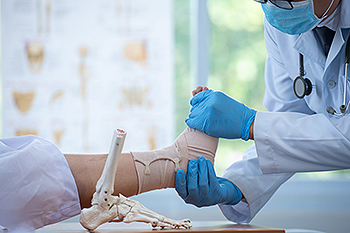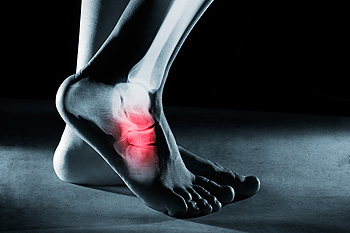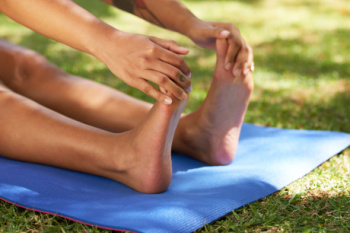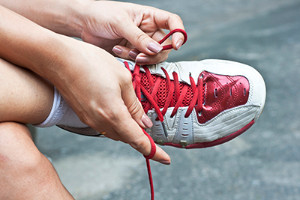Items filtered by date: March 2024
Accelerating Recovery From a Broken Ankle

Recovering from a broken ankle can be a challenging journey, but there are steps individuals can take to expedite the healing process and regain mobility sooner. This can begin by following the guidance of a podiatrist and adhering to the prescribed treatment plan, which may include immobilization through a cast or brace. Elevating the injured ankle above heart level can help reduce swelling and alleviate discomfort. Engaging in gentle range-of-motion exercises can prevent stiffness and promote flexibility in the ankle joint. Adequate nutrition, including foods rich in calcium and vitamin D, supports bone health and aids in the healing process. Finally, maintaining a positive mindset and practicing patience are essential aspects of recovery, as healing from a broken ankle takes time and diligence. If you have broken your ankle, it is suggested that you are under the care of a podiatrist who can provide you with additional recovery tips.
Broken ankles need immediate treatment. If you are seeking treatment, contact Dr. Paul Drucker from NYC Foot Care, PC. Our doctor can provide the care you need to keep you pain-free and on your feet.
Broken Ankles
A broken ankle is experienced when a person fractures their tibia or fibula in the lower leg and ankle area. Both of these bones are attached at the bottom of the leg and combine to form what we know to be our ankle.
When a physician is referring to a break of the ankle, he or she is usually referring to a break in the area where the tibia and fibula are joined to create our ankle joint. Ankles are more prone to fractures because the ankle is an area that suffers a lot of pressure and stress. There are some obvious signs when a person experiences a fractured ankle, and the following symptoms may be present.
Symptoms of a Fractured Ankle
- Excessive pain when the area is touched or when any pressure is placed on the ankle
- Swelling around the area
- Bruising of the area
- Area appears to be deformed
If you suspect an ankle fracture, it is recommended to seek treatment as soon as possible. The sooner you have your podiatrist diagnose the fracture, the quicker you’ll be on the way towards recovery.
If you have any questions, please feel free to contact our offices located in 70th Street Manhattan, 60th Street Manhattan, Jamaica, Queens, Plainview, NY and Fair Lawn, NJ . We offer the newest diagnostic and treatment technologies for all your foot care needs.
Foot Stress Fracture Symptoms

Foot stress fractures, though difficult to recognize, can have a significant impact on daily life. Stress fractures, often caused by repetitive impact and overuse, cause localized pain in the affected foot. This pain typically worsens during weight-bearing activities but subsides with rest. Swelling and tenderness surrounding the injury site are common, sometimes accompanied by bruising. It is important to note that symptoms can be gradual, with pain developing over time as opposed to a sudden onset. As stress fractures can occur in various foot bones, the specific location of pain can offer insights into the affected area. Seeking professional medical evaluation from a podiatrist for persistent or worsening symptoms is important to prevent long-term complications. If feel you may have a foot stress fracture, it is suggested that you consult a podiatrist who can conduct an exam and prescribe treatment methods that are correct for you.
Activities where too much pressure is put on the feet can cause stress fractures. To learn more, contact Dr. Paul Drucker from NYC Foot Care, PC. Our doctor can provide the care you need to keep your pain free and on your feet.
Dealing with Stress Fractures of the Foot and Ankle
Stress fractures occur in the foot and ankle when muscles in these areas weaken from too much or too little use. The feet and ankles then lose support when walking or running from the impact of the ground. Since there is no protection, the bones receive the full impact of each step. Stress on the feet can cause cracks to form in the bones, thus creating stress fractures.
What Are Stress Fractures?
Stress fractures occur frequently in individuals whose daily activities cause great impact on the feet and ankles. Stress factors are most common among:
- Runners
- People affected with Osteoporosis
- Tennis or basketball players
- Gymnasts
- High impact workouts
Symptoms
Pain from the fractures occur in the area of the fractures and can be constant or intermittent. It will often cause sharp or dull pain with swelling and tenderness. Engaging in any kind of activity which involves high impact will aggravate pain.
If you have any questions please feel free to contact our offices located in 70th Street Manhattan, 60th Street Manhattan, Jamaica, Queens, Plainview, NY and Fair Lawn, NJ . We offer the newest diagnostic and treatment technologies for all your foot and ankle needs.
Daily Foot Stretches to Ease Pain
 Incorporating stretches into your daily routine can significantly enhance the health of your feet and legs, potentially mitigating aches and the risk of injury. For example, the seated calf stretch targets the muscles at the back of your lower leg, pivotal for walking and maintaining balance. To perform this stretch, sit with your legs extended forward and a towel looped around the foot's ball. Gently pull on the towel ends, drawing your toes towards you, feeling a deliberate stretch along your calf muscles. Another beneficial stretch, the toe spread, focuses on the intrinsic muscles of your feet, which support your arches and improve toe dexterity. While seated, place your feet flat on the ground and attempt to spread your toes apart without moving your feet, holding the position to enhance muscle strength and flexibility. Bring the toes back together, and repeat this exercise several times. Lastly, the standing calf stretch is performed by placing your hands on a wall and putting one foot behind the other. Gently leaning forward while keeping the back heel on the ground stretches both the calf muscles and the Achilles tendon. If you’re experiencing pain or aches in the feet, it is suggested you make an appointment with a podiatrist to diagnose any potential problems and get more information about beneficial stretches for the feet.
Incorporating stretches into your daily routine can significantly enhance the health of your feet and legs, potentially mitigating aches and the risk of injury. For example, the seated calf stretch targets the muscles at the back of your lower leg, pivotal for walking and maintaining balance. To perform this stretch, sit with your legs extended forward and a towel looped around the foot's ball. Gently pull on the towel ends, drawing your toes towards you, feeling a deliberate stretch along your calf muscles. Another beneficial stretch, the toe spread, focuses on the intrinsic muscles of your feet, which support your arches and improve toe dexterity. While seated, place your feet flat on the ground and attempt to spread your toes apart without moving your feet, holding the position to enhance muscle strength and flexibility. Bring the toes back together, and repeat this exercise several times. Lastly, the standing calf stretch is performed by placing your hands on a wall and putting one foot behind the other. Gently leaning forward while keeping the back heel on the ground stretches both the calf muscles and the Achilles tendon. If you’re experiencing pain or aches in the feet, it is suggested you make an appointment with a podiatrist to diagnose any potential problems and get more information about beneficial stretches for the feet.
Exercising your feet regularly with the proper foot wear is a great way to prevent injuries and build strength. If you have any concerns about your feet, contact Dr. Paul Drucker from NYC Foot Care, PC. Our doctor can provide the care you need to keep you pain-free and on your feet.
Exercise for Your Feet
Exercise for your feet can help you gain strength, mobility and flexibility in your feet. They say that strengthening your feet can be just as rewarding as strengthening another part of the body. Your feet are very important, and we often forget about them in our daily tasks. But it is because of our feet that are we able to get going and do what we need to. For those of us fortunate enough to not have any foot problems, it is an important gesture to take care of them to ensure good health in the long run.
Some foot health exercises can include ankle pumps, tip-toeing, toe rises, lifting off the floor doing reps and sets, and flexing the toes. It is best to speak with Our doctor to determine an appropriate regimen for your needs. Everyone’s needs and bodies are different, and the activities required to maintain strength in the feet vary from individual to individual.
Once you get into a routine of doing regular exercise, you may notice a difference in your feet and how strong they may become.
If you have any questions please feel free to contact our offices located in 70th Street Manhattan, 60th Street Manhattan, Jamaica, Queens, Plainview, NY and Fair Lawn, NJ . We offer the newest diagnostic and treatment technologies for all your foot and ankle needs.
Arthritis Can Cause Pain in the Feet and Ankles
Selecting the Perfect Running Shoes for Various Terrains

Choosing the right running shoes tailored to different terrains is vital for optimal performance and injury prevention. For road running, prioritize lightweight shoes with ample cushioning to absorb impact on hard surfaces. Look for durable outsoles with good traction for stability and grip on pavement. Trail running demands shoes with rugged outsoles and aggressive tread patterns to navigate uneven terrain and provide traction on dirt, mud, and rocks. Opt for shoes with protective features, such as rock plates or toe guards to shield your feet from sharp objects. In wet or slippery conditions, consider waterproof or water-resistant shoes with quick-drying materials to keep your feet dry and comfortable. When running on tracks, lightweight and responsive shoes with minimal cushioning are ideal for speed and agility. Finally, for cross-country running, choose versatile shoes that offer a balance of cushioning, support, and traction to handle various surfaces. By selecting the appropriate footwear for each terrain, you can enhance your running experience and minimize the risk of injuries. If you are seeking additional information about what type of shoes to choose for your preferred running style, it is suggested that you consult a podiatrist.
If you are a runner, wearing the right running shoe is essential. For more information, contact Dr. Paul Drucker from NYC Foot Care, PC. Our doctor can provide the care you need to keep you pain-free and on your feet.
Choosing the Right Running Shoe for Your Foot Type
To increase performance and avoid the risk of injury, it is important to choose the right running shoe based on your foot type. The general design of running shoes revolves around pronation, which is how the ankle rolls from outside to inside when the foot strikes the ground.
- Neutral runners are able to choose from a wide variety of shoes, including minimalist shoes or even going barefoot.
- Runners who overpronate, or experience an over-abundance of ankle rolling, should choose shoes that provide extra motion control and stability.
- Runners who underpronate, or supinate, have feet that have high arches and lack flexibility, preventing shock absorption. They require shoes with more flexibility and cushion.
If you have any questions please feel free to contact our offices located in 70th Street Manhattan, 60th Street Manhattan, Jamaica, Queens, Plainview, NY and Fair Lawn, NJ . We offer the newest diagnostic and treatment technologies for all your foot and ankle needs.

